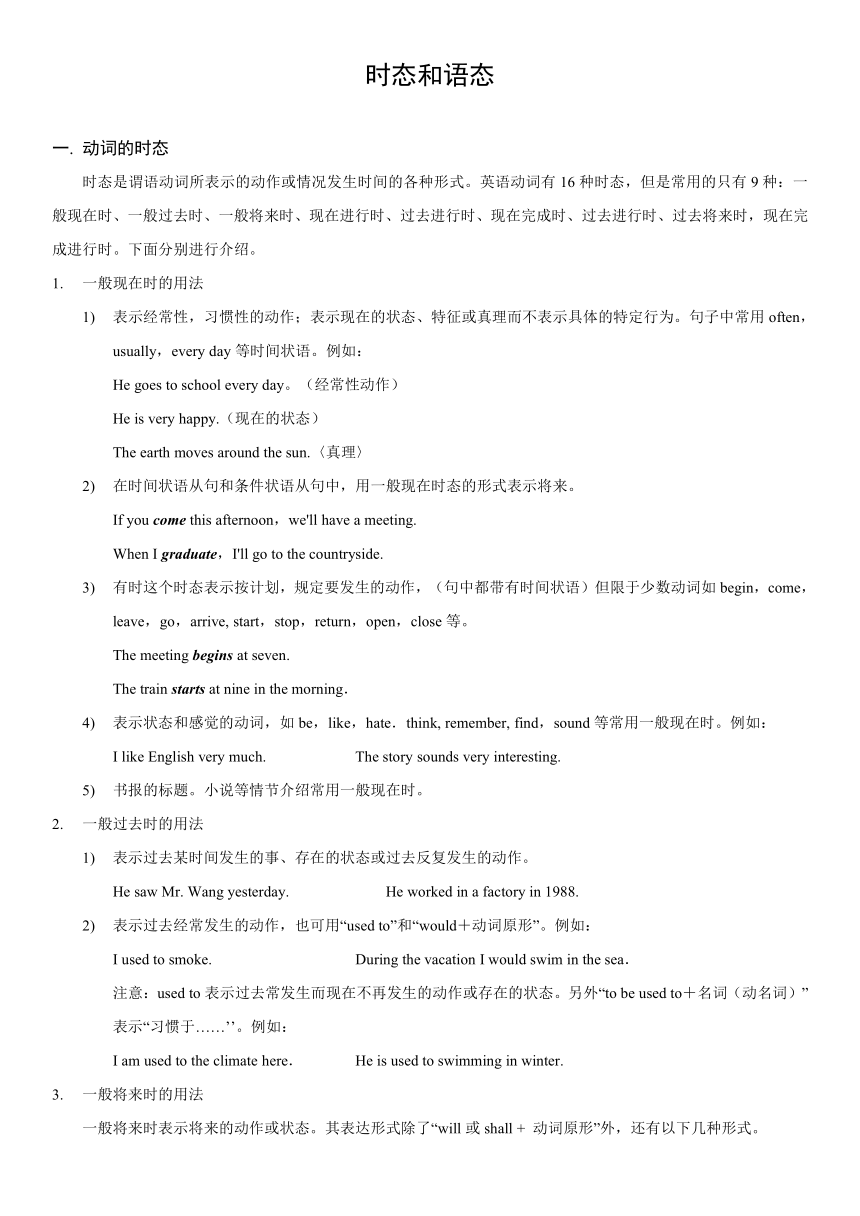
时态和语态 动词的时态 时态是谓语动词所表示的动作或情况发生时间的各种形式。英语动词有16种时态,但是常用的只有9种:一般现在时、一般过去时、一般将来时、现在进行时、过去进行时、现在完成时、过去进行时、过去将来时,现在完成进行时。下面分别进行介绍。 一般现在时的用法 表示经常性,习惯性的动作;表示现在的状态、特征或真理而不表示具体的特定行为。句子中常用often,usually,every day等时间状语。例如: He goes to school every day。(经常性动作) He is very happy.(现在的状态) The earth moves around the sun.〈真理〉 在时间状语从句和条件状语从句中,用一般现在时态的形式表示将来。 If you come this afternoon,we'll have a meeting. When I graduate,I'll go to the countryside. 有时这个时态表示按计划,规定要发生的动作,(句中都带有时间状语)但限于少数动词如begin,come,leave,go,arrive, start,stop,return,open,close等。 The meeting begins at seven. The train starts at nine in the morning. 表示状态和感觉的动词,如be,like,hate.think, remember, find,sound等常用一般现在时。例如: I like English very much. The story sounds very interesting. 书报的标题。小说等情节介绍常用一般现在时。 一般过去时的用法 表示过去某时间发生的事、存在的状态或过去反复发生的动作。 He saw Mr. Wang yesterday. He worked in a factory in 1988. 表示过去经常发生的动作,也可用“used to”和“would+动词原形”。例如: I used to smoke. During the vacation I would swim in the sea. 注意:used to表示过去常发生而现在不再发生的动作或存在的状态。另外“to be used to+名词(动名词)”表示“习惯于……’’。例如: I am used to the climate here. He is used to swimming in winter. 一般将来时的用法 一般将来时表示将来的动作或状态。其表达形式除了“will或shall + 动词原形”外,还有以下几种形式。 “to be going to+动词原形”,表示即将发生的或最近打算进行的事。例如: It is going to rain. We are going to have a meeting today. go, come, start, move, leave, arrive, stay等可用进行时态表示按计划即将发生的动作。 I’m leaving for Beijing. Next week I’m staying in the country for days. “be to + 动词原形”表示按计划要发生的事或征求对方意见。 Are we to go on with this work The boy is to go to school tomorrow. “be about to+动词原形” 表示即刻发生的动作,意为:be ready to do sth.后面一般不跟时间状语。例如: We are about to leave. I’m about to start out. 某些词,如come,go,leave,arrive,start,get,stay等的一般现在时也可表示将来。 The meeting starts at five o'clock. He gets off at the next stop. 现在进行时 现在进行时表示现在正在进行的动作,由“to be + 现在分词”构成,另外“系动词十介词或副词”也表示进行时的意义。例如: What are you doing The bridge is under construction. 表示感觉,愿望和状态的某些动词如:have, be, hear, see, like等词一般不用进行时。 非持续性动词一般不用进行时态,但当用于进行时态时所表达的意义是:a) 逐渐地。 b) 反复进行的动作。例如: a) I’m beginning to understand it. (我慢慢开始明白了。) b) The monkey is jumping up and down there. (那只猴子在那一直上上下下跳个不停。) 有的句子用一般现在时态和进行时态均可,但用进行时态往往带有感彩。比较: The Changjiang River flows to the east. (长江向东流。 客观现实) The ... ...
~~ 您好,已阅读到文档的结尾了 ~~

